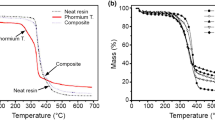Abstract
The increasing demand for high-performance materials has led to the development of natural fiber composites as an alternative to synthetic fiber composites. However, the low thermal conductivity of natural fibers limits their use in advanced applications. In this study, we have developed polyaniline-coated natural fiber composites to enhance their thermal properties. The methodology of this study involves the preparation of natural fiber composites using polyaniline-coated natural fibers as a reinforcement and a bio-based resin as a matrix. The composites were then coated with polyaniline, which was synthesized through chemical oxidation of aniline monomer. The coated composites were characterized using various analytical techniques such as Fourier-transform infrared spectroscopy, scanning electron microscopy, and thermogravimetric analysis to evaluate their structural, morphological, and thermal properties. The materials used in this study were natural fibers, bio-based resin, aniline monomer, ammonium persulfate, and hydrochloric acid. The gap identification of this study is the low thermal conductivity of natural fiber composites, which limits their application in advanced fields such as aerospace, automotive, and electronics. The problem identification is the lack of a cost-effective and eco-friendly method to enhance the thermal properties of natural fiber composites. The results of this study showed that the polyaniline-coated natural fiber composites exhibited enhanced thermal conductivity compared to the uncoated composites. The improvement in the properties of the composites was attributed to the high conductivity of polyaniline and its ability to form a continuous conductive network throughout the composite matrix. The development of polyaniline-coated natural fiber composites provides a cost-effective and eco-friendly approach to enhance the thermal properties of natural fiber composites. This approach has the potential to expand the use of natural fiber composites in advanced applications, leading to a sustainable and greener future.



















Similar content being viewed by others
References
A.H. Majeed, et al., Review Article A Review on Polyaniline: Synthesis, Properties, Nanocomposites, and Electrochemical Applications, Int. J. Polym. Sci., 2022 https://doi.org/10.1155/2022/9047554
S.R. Yashas, B. Shahmoradi, K. Wantala, and H.P. Shivaraju, Potentiality of Polymer Nanocomposites for Sustainable Environmental Applications: A Review of Recent Advances, Polymer, 2021 https://doi.org/10.1016/j.polymer.2021.124184
S. Zhang, Z. Gao, Q. Jia, N. Liu, J. Zhang, and K. Kou, Fabrication and Characterization of Surface Modified HMX@PANI Core-Shell Composites with Enhanced Thermal Properties and Desensitization via In Situ Polymerization, Appl. Surf. Sci., 2020 https://doi.org/10.1016/j.apsusc.2020.146042
S. Thambidurai and K. Pandiselvi, Polyaniline/Natural Polymer Composites and Nanocomposites, Polyaniline Blends Compos. Nanocompos., 2018 https://doi.org/10.1016/B978-0-12-809551-5.00009-6
W. Kong, et al., Polyaniline-Decorated Carbon Fibers for Enhanced Mechanical and Electromagnetic Interference Shielding Performances of Epoxy Composites, Mater. Des., 2022 https://doi.org/10.1016/j.matdes.2022.110658
X.L. Ma, G.T. Fei, and S.H. Xu, Synthesis of Polyaniline Coating on the Modified Fiber Ball and Application for Cr(VI) Removal, Nanoscale Res. Lett., 2021 https://doi.org/10.1186/S11671-021-03509-Y
M.A. Deyab and Q. Mohsen, Controlling the Corrosion and Hydrogen Gas Liberation Inside Lead-Acid Battery via PANI/Cu-Pp/CNTs Nanocomposite Coating, Sci. Rep., 2021 https://doi.org/10.1038/S41598-021-88972-4
S.R. Mohanty and S.K. Biswal, An Overview of Removal of Heavy Metal Ions from Toxic Aqueous Solution Using Pani-Based Adsorbents, Micro Nanosyst., 2021, 14(2), p 144–155. https://doi.org/10.2174/1876402913666210126150157
N. Shoukat, et al., Fabrication of CuO-NiO Wrapped Cellulose Acetate/Polyaniline Electrospun Nanofibers for Sensitive Monitoring of Bisphenol-A, ACS Sustain. Chem. Eng., 2022 https://doi.org/10.1021/ACSSUSCHEMENG.2C04482
J. Bhadra, A. Alkareem, and N. Al-Thani, A Review of Advances in the Preparation and Application of Polyaniline Based Thermoset Blends and Composites, J. Polym. Res., 2020 https://doi.org/10.1007/S10965-020-02052-1
M.A. Tarawneh, et al., Mechanical, Thermal, and Conductivity Performances of novel Thermoplastic Natural Rubber/Graphene Nanoplates/Polyaniline Composites, J. Appl. Polym. Sci., 2020 https://doi.org/10.1002/APP.48873
S.E. Bourdo, B.A. Warford, and T. Viswanathan, Electrical and Thermal Properties of Graphite/Polyaniline Composites, J. Solid State Chem., 2012, 196, p 309–313. https://doi.org/10.1016/j.jssc.2012.06.038
Author information
Authors and Affiliations
Contributions
All authors contributed to the study conception and design. Model preparation, data collection and analysis were performed by RK, RS, RS.
Corresponding author
Additional information
Publisher's Note
Springer Nature remains neutral with regard to jurisdictional claims in published maps and institutional affiliations.
Rights and permissions
Springer Nature or its licensor (e.g. a society or other partner) holds exclusive rights to this article under a publishing agreement with the author(s) or other rightsholder(s); author self-archiving of the accepted manuscript version of this article is solely governed by the terms of such publishing agreement and applicable law.
About this article
Cite this article
Karthikeyan, R., Sridhar, R. & Suresh, R. Development of Polyaniline-Coated Natural Fiber Composites for Enhanced Thermal Properties. J. of Materi Eng and Perform (2023). https://doi.org/10.1007/s11665-023-08678-8
Received:
Revised:
Accepted:
Published:
DOI: https://doi.org/10.1007/s11665-023-08678-8




